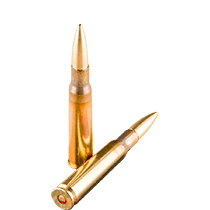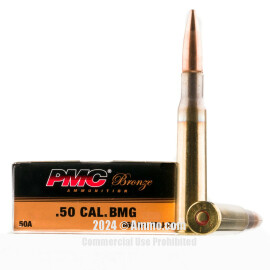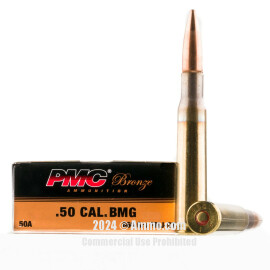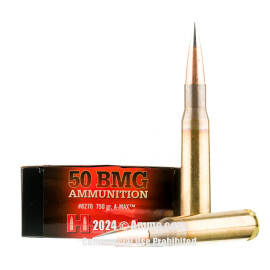
50 BMG Ammo For Sale
History of 50 BMG Ammo
Developed during the second decade of the 20th century and adopted into a service ammunition in 1921, the .50 Browning Machine Gun (BMG) round is one of the most widely used service ammunitions to date. Also known as the .50 Browning, the 12.7x99mm NATO round is used today across the globe. It’s currently listed as military ammunition for the U.S. and at least 30 other countries.
The .50 BMG spawned from an expanded .30-06 case, which gave the shell its rimless, bottleneck shape. The shoulder diameter of the casing measures .735 inch, with the base measuring at .804 inch. A 3.91-inch shell secures a jacketed lead bullet with a .510-inch diameter.
The full round measures 5.45 inches, making it a powerful and extremely deadly cartridge.
A #35 arsenal primer charges the ammunition. And its maximum pressure varies from 53,664 pounds per square inch (psi) to 60,481 psi, depending on the ammo's purpose and user.
Development of .50 BMG Ammo
The idea of the .50 Browning developed during World War I and was said to be inspired by Germany’s Mauser 13.2mm TuF (Tank und Flieger, which translates as “tank and aircraft”) anti-tank rifles and ammunitions. The 13.2mm TuF was the first ammunition that was intentionally made to attack armored targets and drew attention from those who witnessed its forces.
To create their own armor-attacking ammunition, the Army went to John Moses Browning, the renowned gunsmith, to discuss their needs. They wanted a machine-gun fired, heavy projectile that could reach a velocity of up to 2,700 feet per second (fps).
Browning agreed with the military’s need and has even been quoted as saying: “Well, the cartridge sounds pretty good to start. You make up some cartridges and we’ll do some shooting.”
Army officials then contacted Winchester Arms for ammunition, which later joined forces with Frankfort Arsenal to complete the round, while Browning worked on the firearm. Winchester and Frankfort Arsenal scaled up the .30-06 casing to a much bigger size and loaded it to the max.
By the end of WW1, Browning, with the help of Colt Manufacturing Company, had the prototypes ready for testing. The Army opted for the M1921 Browning machine gun, an expanded version of the earlier machine guns, the M1917 and M1919.
This gun eventually became known as the M2HB Browning, where HB stands for heavy barrel. It has proven itself to be an anti-aircraft, anti-vehicular, armour-piercing machine gun that’s still extensively used to today, mounted on tanks, helicopters, and more, in both the U.S. and many other NATO countries.
Military Uses of the .50 BMG
As its development started at the end of the Great War, the .50 BMG and the machine guns chambered for it were prevalent and influential in all areas of the Armed Forces – including the U.S. Navy, the U.S. Army, the U.S. Marine Corp, and the U.S. Air Force.
Although there were various adaptations of the weapon, two models were the most prevalent – a lighter-barrelled version designed to use in aircraft (M2) and a heavy-barrelled ground version (M2HB).
The M2 and its variants have been fired from vehicle-mounted weapons, including WWII fighter aircraft, and are still being used today on tanks and other ground vehicles. Machine guns have also led to the global air supremacy of the U.S. Armed Forces and these guns are often seen on helicopters, aircrafts, and more.
The cartridge is also fired from sniper rifles. It’s accurate and deadly at great lengths. These bullets can travel well over a mile and can be used to eliminate threats and neutralize an infantry while avoiding detection and relationation.
This ammunition has the ability to penetrate most commercial brick walls and it can blow through concrete cinder block. When fired into an engine, it can completely disable a vehicle.
There is no living thing on Earth that cannot be killed by the .50 BMG.
To help put the .50 caliber and M2 into perspective, here are a list of wars they were used in:
- World War II
- Korean War
- Vietnam War
- Cambodian Civil War
- Falklands War
- Persian Gulf War
- Global War on Terrorism
- Iraq War
- War in Afghanistan
- Syrian Civil War
- Iraqi Civil War
- Yemeni Civil War
- Saudi-led Invasion of Yemen
Civilian Uses of .50 BMG Ammunition
Beyond the American Armed Forces, the .50 Browning has also found its place with the U.S. Coast Guard, the New York Police Department (NYPD), and the Pittsburgh Police.
Among the general public, the .50 BMG has found a home in competition shooting. There’s even a Fifty Caliber Shooters Association (FCSA), which holds annual 1,000 yard events (1,000 yards is .568 mile).
With five shots at 1,000 yards, top shooters can achieve six-inch groupings. With mild, known wind conditions, they can hit (and explode) a 55-gallon barrel a full mile away.
Legality Surrounding .50 BMG Ammo
While the average American is not allowed to possess fully-automatic weapons, making the M2 inaccessible to the majority, the .50 BMG is chambered in a handful of rifles and carbines available for civilians.
But that doesn’t mean all American civilians. The ammunition and the firearms chambered for it are highly regulated or banned in:
- Washington, D.C.
- California
- Connecticut
- Maryland
It should also be noted that the bullet of the .50 BMG measures above the half-inch threshold for defining destructive devices in the United States National Firearms Act. Per Section 5845(f)(2), Title 26 of the United States Code, weapons are classified as “destructive devices” if the following occurs:
“...Any type of weapon by whatever name known which will, or which may be readily converted to, expel a projectile by the action of an explosive or other propellant, the barrel or barrels of which have a bore of more than one-half inch in diameter, except a shotgun or shotgun shell which the Secretary or his delegate finds is generally recognized as particularly suitable for sporting purposes.”
Now some ammunition, including the big bore revolver .500 S&W round, have been forced to stay under that half-inch margin. But notice the language in the law. It doesn’t say that a bullet can’t be beyond a half inch – it says that the firearm’s barrel can’t have a bore larger than a half inch.
In firearms chambered for the .50 Browning, the barrel measures exactly half an inch across the rifling lands. In the rifling grooves, the measurement is slightly larger. The bullet has such force behind it upon firing, that it’s forced through the smaller rifling, in a process known as swaging. Swaging allows for full engagement of the barrel’s rifling and forms a tighter seal around the projectile.
Swaging allows the .50 BMG’s .510-inch bullet to remain legal in most of the country.
Types of .50 BMG Rounds
The standard .50 BMG military load fires a full metal jacket (FMJ) bullet weighing 647 grain (gr) and travels at a velocity just more than 3,000 feet per second (fps) when fired from the M2 heavy machine gun, with a barrell length of 45 inches. Heavier bullets weighing 800 gr and reaching 2,900 fps have also been used.
Rounds designed to use in a machine gun are manufactured on a continuous belt that’s fitted with metal clips to hold it together.
When fired from a sniper rifle, which may have a significantly shorter barrel, the muzzle velocities are, understandably, lower.
Fifty Browning Machine Gun cartridges come in various loads and configurations. Some of the most popular include:
- Ball: The military terminology for FMJ bullets, these feature a solid lead bullet, jacketed in a harder metal, typically copper.
- Armor-piercing (AP): Designed to blast through the armor on warships, these bullets are now constructed entirely of tungsten, iron, or steel alloys. This type of ammunition is used in all anti-tank warfare.
- Tracer: Tracer ammo contains a pyrotechnic charge on the projectile, which ignites during firing, causing a very bright and visible trajectory that the shooter can see both in light and dark conditions. This bullet trace allows the shooter to adjust their aim without being able to see exactly where they hit and to show other shooters where to concentrate their firing during live-action warfare.
- Saboted sub-caliber: These rounds use a device to hold a sub-caliber (smaller) round in the middle of the barrel to allow for the best flight performance while shooting.
- Incendiary: Originally made with phosphorus, incendiary cartridges catch fire and burn rapidly. They can even penetrate bomber aircraft and easily ignite fuel tanks.
.50 BMG Machine Guns and Rifles
The M2HB machine gun is the most famous weapon chambered for the .50 BMG cartridge. It’s so powerful that it can completely perforate a .875-inch face-hardened steel plate at 100 yards. At 547 yards (500 meters), the bullet can perforate a .75-inch steel plate.
The M2HB, technically called the Caliber .50 Machine Gun, Heavy Barrel, Model 2, was the second model designed for the .50 Browning and consisted of a heavier barrel for ground use, with the idea that the heftier barrel could withstand the heat from firing multiple rounds.
With a 45-inch barrel, the M2HB weighs 84 pounds on its own, 120 pounds on its tripod. Its overall length of 65 inches leaves no doubt that the M2HB is heavy and cumbersome, but yet, it’s still used today, nearly 100 years after its conception. And that’s because its range and accuracy are beyond superior to anything the military’s produced in its lighter automatic weapons.
The massive firearm functions with a short recoil operation and is air-cooled with an adjustable headspace. The belt of .50 BMG ammunition can be fed from either the right or left side, and it’s effective up to an astonishing 6,800 meters (or just over 4.2 miles).
The M2HB, as well as other M2 variants, fired 850 rounds per minute, wreaking havoc on enemy camps and infantaries.
.50 BMG ammo is also chambered in the M3 machine gun. Although it’s much like the M2, the M3 fires significantly faster at 1,000 rounds per minute and was designed to be fitted onto the wing or fuselage of a fighter plane.
The Barrett M82/M107 family of sniper rifles were the first shoulder-fired semi-autos chambered in .50 Browning, and are now used in combat scenarios around the world.
Popular civilian rifles and carbines include the M82 and its modern version, the M107, as well as a range of slightly more affordable .50 BMG chambered weapons. Shooters can expect to find these options, ranging from single action firearms around $2,000 on the less expensive side, upwards of $12,000 for standard high quality pieces. When it comes to customization, shooters can spend astronomical amounts for more custom firearms.
Some of the most popular include:
- MacMillan TAC-50
- Armalite AR-50
- Desert Tech HTI
- Noreen Ultra Long Range (ULR)
- Bushmaster BA50 Carbine
- Serhu Firearms BFG-50 Carbine
While speaking of cost, just like the words “affordable” and “M107” don’t fit well together, cheap .50 BMG ammo is a bit of an oxymoron. When shooters buy bulk .50 BMG ammo or find military surplus .50 BMG, they can save a few dollars, but in most cases, the average price of these cartridges is about $3 a round.
The .50 BMG has graced the American Armed Forces since before World War II, and has earned its place as an American icon. From soldiers in trenches to snipers on rooftops, the .50 BMG has influenced the last century in more ways than one.
Although it’s no longer the biggest ammunition cartridge available, it has always been and always will be “the big one.”
FAQ
What is 50 BMG ammo?
The .50 Browning Machine Gun (BMG) round is a large-bore, long-distance sniper round used by the U.S. Military and the armed forces of at least 30 other countries. The cartridge features a full metal jacket projectile that measures .510 inch in diameter and sits in a casing that’s nearly four inches in length. The full round is 5.45 inches long.
How do you delink .50 BMG ammo?
When purchasing surplus ammo in .50 BMG, it often comes linked together for feeding into a machine gun, but these rounds can be delinked. Although special delinking tools are available, they’re often not necessary. Instead, press individual bullet tips into a hard surface, such as a workbench, and pry down. This allows the cartridge to pop free from the metal link.
How many 50 BMG bullets come in an ammo box?
When purchasing .50 BMG rounds, different box sizes are available. It’s common to find the caliber sold in boxes of 10 rounds. If looking for bulk ammo, .50 BMG is available in both 100 and 200 round boxes.
What is the effective range of the 50 BMG?
The .50 BMG is a long-range round. It’s generally considered effective up to 1,800 yards (1.1 mile), and even further in some military sniper rifles. It’s known to be able to hit and explode 55-gallon barrels a mile away and the Fifty Caliber Shooters Association, a civilian target shooting group, holds annual 1,000 yard events, where top shooters can achieve six-inch groupings.
Can you hunt with .50 BMG ammunition?
The .50 BMG is not considered an effective hunting round. Although it is powerful enough to harvest any game, this high powered round is overkill, even for elephants. If the price per bullet and the weight of rifles chambered in .50 BMG weren’t enough to deter you, then the fact that little meat would be left suitable for consumption may. If you really do want to harvest game with the BMG, consider a down-graded wildcat round with less velocity and energy to avoid complete devastation.
50 BMG Ballistics: Chart of Average 50 BMG Ballistics
Note: This information comes from the manufacturer and is for informational purposes only. The actual ballistics obtained with your firearm can vary considerably from the advertised ballistics. Also, ballistics can vary from lot to lot with the same brand and type load.
| 50 BMG Bullet WEIGHT | Muzzle VELOCITY (fps) | Muzzle ENERGY (ft. lbs.) | TRAJECTORY (in.) | |||||||||||
|---|---|---|---|---|---|---|---|---|---|---|---|---|---|---|
| Muzzle | 100 yds. | 200 yds. | 300 yds. | 400 yds. | Muzzle | 100 yds. | 200 yds. | 300 yds. | 400 yds. | 100 yds. | 200 yds. | 300 yds. | 400 yds. | |
| 660 Grain PMC | 3080 | 2854 | 2639 | 2444 | 2248 | 13668 | n/a | n/a | 500 yd. zero | n/a | 3.1 | 3.9 | 4.7 | 2.8 |
| 750 Grain Match | 2820 | 2728 | 2637 | 2549 | 2462 | 13241 | 12388 | 11580 | 10815 | 10090 | 1.5 | 0 | -6.5 | -18.3 |
Customer Reviews
-
T-Rex said:
Great value for your money. I plan on buying more. I have fun shooting this caliber rifle. It helps with all my frustrations.
-
m82a1` said:
Federal 50BMG in 660 grain FMJ is an excellent all-round 50BMG round, and as provided here at ammo.com is also a great value, especially in the 100 round box (10 boxes of 10 rounds each). I've been shooting this 50BMG round for almost as long as I've had my Barrett M82A1 and it performs well and I have yet to miss-fire or have issues chambering or cycling the rounds, even if ripping off multiple shots in quick succession [not easy at this caliber]. The brass is high quality and a good reload. I recommend this round to anyone who needs a general purpose FMJ round for practice or competition [caveat, I do not currently compete], for using "ready-made" rounds.
-
CatDad said:
This is decent steel cored M33 ball equivalent. Chronoed at 2875fps out of a 30” barrel. 2” groups at 100yds. Still fantastic and affordable ammo for 1000+ yard shooting and practice.


















